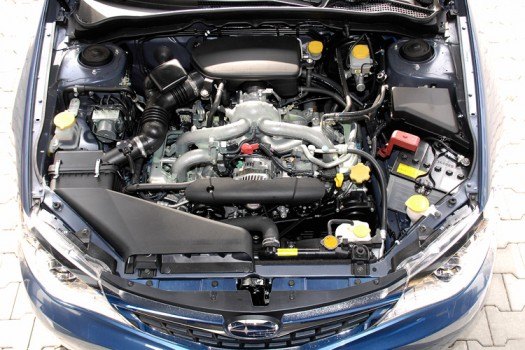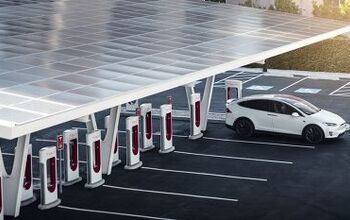Subaru Expands Brand To "RF" Status

The financial crisis will (this is an easy prediction to make) have a strange effect on some car brands (see Honda). A few car makers will try to move upwards towards Panameran profitability, while others will try to be anything to anybody as long as that somebody is a buyer. A few brands will steer themselves downwards in a more or less desperate grab at recession-resistance sales. And it seems that Subaru is one of them. If you think the Subaru brand means “sporty, 4WD, boxer-engined, super-reliable”, then you’re in for a surprise. If European Subarus are indicative of worldwide strategy, then two out of four of those are goners. The new Impreza 1.5 RF (Revolution Frontwheel, not a deliberate jab at Robert Farago’s loathing for brand dilution), is weak (107 HP), slow (0-60 in 13.2 sec), and FWD. It has only disc brakes in the front and lists for 16.5K € in Germany, which will probably amount to around 11K net after rebates. So it’s cheap and dull. Will people buy it?
Subaru grew in Germany in 2008, against the trend, and has high hopes for its decontented devices. Spiegel Online says the insipid Impreza is a pleasant drive, and of course the boxer engine still sounds nice (click on “Anfahren” to hear a few seconds of acceleration). But isn’t this kind of car detrimental to the Subaru brand? In Europe, Subaru already sells the Justy, which is a 2WD version of the musty, miniscule Daihatsu Sirion. 0-60 is not everything, I don’t give a damn about 4WD, and difficult times call for different cars, but Subaru should be careful not to fall into a brand-dilution trap.

More by Martin Schwoerer


































Comments
Join the conversation
dgduris thanks for the correction. A buddy of mine who follows this site mentioned that to me last night too, but the only subaru I've driven recently is his WRX (very not stock) so my experience with their AWD is based on my college years. The FWD biased AWD system is one of the great mysteries to me. None of RWD's advantages (maneuvarability, steering feel), all of FWD's disadvantages (torque steer, understeer, awful steering) and really not very good handling (snap oversteer due to late and awkward application of RWD power). It may be fine if you keep it pinned on loose gravel, keeping the system busy, but is probably the worst drivetrain possible in regular road cars (IMO).
I've driven small Subarus in New Zealand, which has many narrow, winding gravel roads. We mostly drove in 2-WD to save petrol, but on gravelly hills, when the car started sliding around, switching to 4-WD made a big difference. The car was immediately more stable and sure-footed.
An AWD won't power oversteer... not unless it's programmed to shift all power rearward, a la Nissan GT-R... and even then, the GT-R is programmed to transfer power forwards when the yaw sensors detect a slide. A FWD-based AWD won't oversteer because of rear-drive application. It will snap oversteer if, and only if, the chassis is designed to oversteer. And you can design the chassis to snap-oversteer because you're confident that the understeer afforded by the AWD system will pull you out of the slide. FWD is easy to make AWD because of the way the engine is situated compared to the wheels. The engine of a FWD is largely clear of the front axle, simplifying conversion. It's merely a matter of adding the torque tube and mounting the rear differential where the rear multilinks commonly hook-up. In other markets, cars such as the Sentra, Lancer (non-Evo, completely different drivetrain) and Protege were offered with AWD. - Maneuverability is a factor based on the car itself, not the drivetrain. A RWD Miata is maneuverable. A RWD E-Class isn't. Steering feel... my FWD Mazda would like to object to that statement... steering depends on how you engineer it... EVO steering isn't particularly feelsome, but it's incredible, nonetheless. The big problem with AWD is the added weight, complexity and power + fuel consumption penalties when attached to less powerful engines.
niky The old Subaru's that I drove certainly did snap oversteer. It was more due to the late power delivery mid-turn than anything else, they certainly had no intention of adding violent oversteer as a perk. To be fair we were young and driving aggresively almost (but not every time) every time it happened. I frequently complain about the Element's handling because I can clearly feel when the power transitions to the rear...and while it may not snap-oversteer I can feel the exact same sensation occuring, probably damped by excess flexibility in the chassis/body or whatever other trick they used to ensure terminal understeer remains dominant. So, I think they compensate for the inherent tendency to snap oversteer by dialing in extra understeer in the suspension setup. The sensation I'm referring to feels much like oversteering into or out of a turn. As for steering feel, I've never driven a FWD car that didn't noticabely suffer due to it's layout. I also love the Mazda3, and have put thousands of miles on my old roomates, but it would only improve the steering feel to make it RWD, that's all I was trying to say about that. In some cases I'd say a sporty car can have very direct steering and be FWD, that is, until you put the car in gear to accelerate of deccelerate. Also, the maneuverability jibe is meant to skewer SUV's mostly. The Element I keep referring to was bought as a replacement for a body on frame bronco, and while it is far better at many things, low speed snow driving is an achillies heel. I simply cannot bring the back around using the throttle, making rear loading from the garage impossible in the winter when snowbanks limit the turning radius. The newer AWD is great at driving across snowy or wet grass without tearing up the lawn on the other hand.